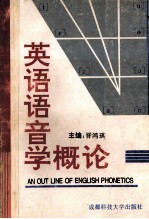
- 作 者:晋鸿琪主编;马英,孙美然,史惠凤等副主编
- 出 版 社:成都:成都科技大学出版社
- 出版年份:1995
- ISBN:7561631359
- 标注页数:313 页
- PDF页数:326 页
请阅读订购服务说明与试读!
订购服务说明
1、本站所有的书默认都是PDF格式,该格式图书只能阅读和打印,不能再次编辑。
2、除分上下册或者多册的情况下,一般PDF页数一定要大于标注页数才建议下单购买。【本资源326 ≥313页】
图书下载及付费说明
1、所有的电子图书为PDF格式,支持电脑、手机、平板等各类电子设备阅读;可以任意拷贝文件到不同的阅读设备里进行阅读。
2、电子图书在提交订单后一般半小时内处理完成,最晚48小时内处理完成。(非工作日购买会延迟)
3、所有的电子图书都是原书直接扫描方式制作而成。
Ⅰ Which Type of English Pronunciation 1
Ⅱ The Pronunciation of Speech 5
1.The Lungues 5
2.The Larynx and the Vocal Cords 5
3.The Resonating Cavities 9
(1)The Pharynx 9
(2)The Nose and the Soft Palate 10
(3)The Mouth 10
4.The Lips 12
5.The Tongue 14
6.Basic Factors of Sound Description 16
Ⅲ The Sounds of Speech 17
1.Judgements of Speech Sounds 17
2.The Formation of Speech Sounds 18
3.Pitch 21
4.Loudness 22
5.Length 23
Ⅳ Classification of Speech Sounds 25
1.Vowel and Consonant 25
2.The Consonantal Type 26
2—1 Place of Articulation 27
2—2 Manner of Articulation 28
2—3 Semi-vowels 30
2—4 Energy of Articulation 30
2—5 Classification of Consonants 31
3.Vowel Type 32
3—1 Difficulties of Description 32
3—2 The Cardinal Vowel Seale 34
3—3 Classification of Vowels 37
Ⅴ Sounds of Spoken Language 40
1.Phonemes and Allophones 40
2.Allophonic Variants 41
3.Notation 43
Ⅵ The English Vowels 45
1.Introduction 45
2.Distinctive Vowels 46
(1)Diagram of the Vowels(pure) 46
(2)Diagram of the Vowels(gliding) 47
(3)Qualities of the Syllabic Vowels 49
3.Description of the Vowels 50
3—1 Monophthongs 51
/i:/ 51
/i/ 54
/e/ 58
/?/ 61
/?/ 65
/a:/ 68
/?/ 71
/?:/ 73
/u/ 78
/u:/ 80
/?:/ 84
/?/ 87
3—2 Diphthongs-Glide 92
/ei/ 93
/ai/ 97
/?i/ 101
/?u/ 104
/?u/ 109
3—3 Diphthongs—Centring(diphthong+/?/) 113
3—4 Centring Diphthongs(glide to/?/) 117
Ⅶ The English Consonants 129
(Ⅰ)Distinctive Consonants 129
(Ⅱ)Consonants with Closure or Stricture(Class A) 130
1.Plosives 130
1—1 Stages of Plosives 130
1—2 Features of Plosives 131
1—3 The Release of Plosives 134
(1)In Final Positions(no release) 134
(2)In Stop Clusters(no release) 134
(3)Glottal of Final/p,t,k/ 136
(4)Nasal Release 136
(5)Lateral Release 137
(6)Affrication of Plosives 138
1—4 Plosives in Pairs 139
/p,b/ 139
/t,d/ 143
/k,g/ 147
/?/ 152
2.Affricates 156
2—1 Definition 156
2—2 Phonemic Status 156
2—3 The Acoustic Features 158
2—4 Affricates in Pairs 158
/t?,d?/ 158
/tr,dr/ 162
3.Fricatives 166
3—1 Features 166
3—2 Fricatives in Pairs 168
/f,v/ 168
/θ.?/ 172
/s,z/ 176
/∫,?/ 179
/h/ 183
(Ⅲ)Glide Consonants(Class B) 186
1.Nasals 186
/m/ 187
/n/ 189
/η/ 192
2.Lateral/l/(/l/), 196
3.Post-alveolar/r/ 202
4.Semi-vowels 208
/j/ 209
/w/ 213
Ⅷ Syllable 218
1.Definition 218
Construction 220
1)Syllabic Sounds 220
2)Forms of Syllables 222
3)Open Syllables 223
4)Closed Syllables 224
5)Pronunciation for Stressed"a,e,i,o,u" 225
6)Pronunciation for Unstressed"a,e,i,o,u" 226
3.Syllabification 227
Ⅸ The word 232
1.Accent 232
2.Prominence 234
(1)Stress 235
(2)Pitch Change 235
(3)Sound Quality 238
(4)Sound Quantity 239
3.Word Accentual Patterns 240
4.Instability of Word Accentual Patterns 246
5.Elission 250
(1)Vowels 250
(2)Consonants 251
Ⅹ Words in Company 253
1.Neutralization of Week Forms 254
2.Allophonic Variations 256
3.Assimilation 260
4.Elission 262
5.Liaison(liking) 265
6.Advice to You 267
Ⅺ Connected Speech 270
1.Accent 270
2.Stress and Rhythem 274
3.Changes of Quantity and Quality 283
1)Accented Words 283
2)Unaccented Words 284
4.Intonation 289
4—1 The Main Functions 289
4—2 Manifestation of the Accentual Function 290
1)Realization of Primary Accent 290
2)Types of Nucleus 292
(1)The Falling Nucleus 292
(2)The Rising Nucleus 293
(3)The Falling-rising Nucleus 294
3)Realization of Secondary Accent 295
(1)Pre-nuclear 295
(2)Post-nuclear 297
(3)Between Fall and Rise 298
4)Realization of Unaccented Syllables 298
(1)Pre-nuclear 298
(2)Within Body 299
(3)Post-nuclear 300
4—3 Manifestation of the Non-accentual Function 301
1)Falling Nuclei 302
(1)Low-falling Nucleus 303
(2)High-falling Nucleus 304
2)Rising Nuclei 305
(1)Low-rising Nucleus 305
(2)High-rising Nucleus 307
(3)Falling-rising Nucleus 308
(4)Multi-nuclear Patterns 309
4—4 Advice for Learning Accent in Connected Speech 312
